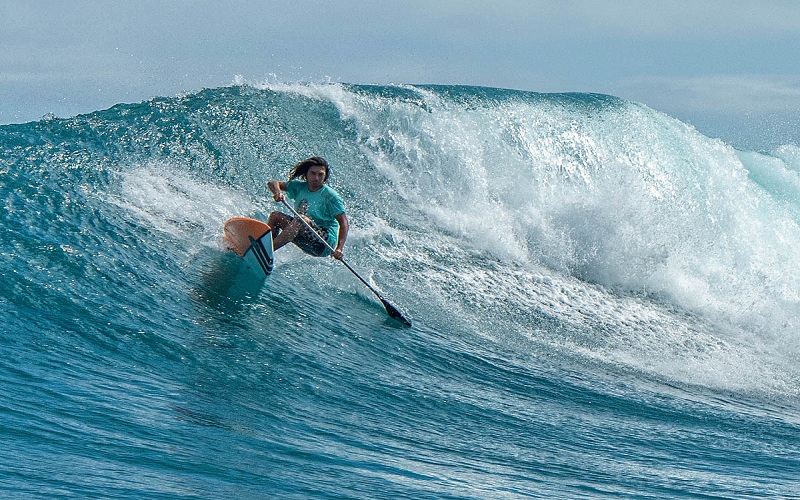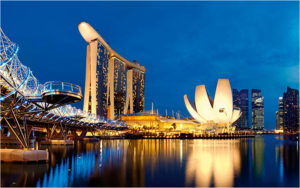Australia has a long history of surfing and the watersport remains one of the most well-celebrated activities by many across the country. The surfing community, however, does not hesitate to welcome new aspects of its culture, as is evidenced by the growing popularity of stand-up paddleboarding (SUP) and the bridge between the two known as SUP surfing or, simply, paddle surfing.
At its core, SUP surfing is very similar to surfing. You seek out a wave and do your best to ride it, working with its trajectory and motion to achieve speed and movement. Outside of this is where the paddleboarding element makes it all quite different.
Those familiar with SUP will know that one of the most attractive aspects of the watersport is that it is immensely easy to begin. Unlike surfing, which requires boarders to overcome a rather steep learning curve and then spend time finding suitable environments and conditions to enjoy themselves, paddleboarders can simply place their board on the water and begin exploring. While there is a modest learning curve with paddleboarding, many find themselves navigating lakes and seafronts soon after beginning.
This ease of use transfers to SUP surfing and actually helps to improve a number of surfing elements. Catching a wave, for instance, is generally considered to be easier on a paddleboard because riders are already stood up and with a paddle that allows them to quickly maneuver into position. The size of a paddleboard also offers a greater degree of stability, making it easier for most to keep themselves upright and in control even when traversing challenging waves.
Such ease on the water does, of course, require choosing the right paddleboard since not all paddleboards are designed for SUP surfing. Boards that are shaped with surfing in mind tend to be shorter than a traditional paddleboard since the former is designed for increased and responsive movement. Paddleboards suitable for surfing will also tend to have a more defined grip pad since stability is challenged more thoroughly by the waves.
Other elements of the watersport are also important to consider, from the chosen paddle to the accessories brought along onto the water. Personal floatation devices and board leashes remain important, just as they are for surfing and paddleboarding. Many SUP surfers will also recommend that beginners consider their outfit too since those new to the watersport will likely end up in the sea as they start out.
Once comfortable with the process and equipment, it’s time to get onto the water. However, there is one final piece of advice that experienced paddle surfers share, which is to practice together. Watersports are celebrated for their communities but the social element also lends itself to safety too. Those stepping out onto the water for the first time, especially when chasing waves, should ideally do so with others. This could be a group of friends who have the experience to recognise risks or it could be with a local club or class, ensuring that newcomers are able to find their feet.




“Каковы долгосрочные последствия нелеченных акне?” – “Нелеченные акне могут привести к постоянным рубцам, темным пятнам и психологическим последствиям, таким как снижение самооценки и тревожность.”
“What are the long-term effects of untreated acne?” – “Untreated acne can lead to permanent scarring, dark spots, and psychological effects like reduced self-esteem and anxiety.”
лечение прыщей на лице препараты https://beautylogy.ru/ .
Здравствуйте!
Для определенных людей, купить диплом о высшем образовании – это острая потребность, уникальный шанс получить выгодную работу. Впрочем для кого-то – это желание не терять множество времени на учебу в университете. С какой бы целью вам это не понадобилось, мы готовы помочь вам. Оперативно, профессионально и по разумной цене сделаем диплом нового или старого образца на настоящих бланках со всеми необходимыми подписями и печатями.
Купить документ о получении высшего образования вы сможете у нас. Мы оказываем услуги по продаже документов об окончании любых университетов Российской Федерации. Вы получите необходимый диплом по любым специальностям, любого года выпуска, в том числе документы Советского Союза. Даем гарантию, что в случае проверки документа работодателями, каких-либо подозрений не возникнет.
Плюсы наших дипломов:
• используем настоящие бланки “Гознак”;
• подлинные подписи должностных лиц;
• все печати ВУЗа;
• специальные водяные знаки, нити и иные степени защиты;
• безупречное качество оформления – ошибок не будет;
• любые проверки документа.
Мы предлагаем выгодно заказать диплом, который выполняется на бланке ГОЗНАКа и заверен мокрыми печатями, водяными знаками, подписями. Данный документ пройдет любые проверки, даже при использовании специального оборудования. Решите свои задачи быстро с нашими дипломами.
Где заказать диплом по необходимой специальности?
http://talkrealty.ru/kupit-diplom-garantiya-kachestva-i-nadezhnosti
Успехов в учебе!
спортивные площадки на улице [url=https://ploshadka-sport.ru]спортивные площадки на улице[/url] .
[u][b] Здравствуйте![/b][/u]
Для определенных людей, заказать [b]диплом[/b] о высшем образовании – это острая потребность, удачный шанс получить хорошую работу. Впрочем для кого-то – это желание не терять множество времени на учебу в институте. Что бы ни толкнуло вас на такое решение, мы готовы помочь. Максимально быстро, профессионально и по разумной стоимости сделаем документ любого года выпуска на государственных бланках со всеми требуемыми печатями.
[b]Наша компания предлагает[/b] выгодно купить диплом, который выполнен на оригинальном бланке и заверен печатями, водяными знаками, подписями официальных лиц. Диплом способен пройти лубую проверку, даже с применением профессиональных приборов. Решите свои задачи быстро и просто с нашей компанией.
[b]Преимущества наших дипломов:[/b]
• используются только фирменные бланки “Гознак”;
• необходимые подписи руководства;
• мокрые печати ВУЗа;
• водяные знаки, нити и прочие степени защиты;
• безупречное качество оформления – ошибок не бывает;
• любые проверки оригинальности документа.
[b]Дипломы и аттестаты об окончании ВУЗов и ССУЗов России:[/b]
– Способны повысить статус владельца;
– Открывают большие возможности на рынке труда;
– Повышают рейтинг в глазах обычных людей;
– Повышают собственную самооценку.
[b]Где купить диплом специалиста?[/b]
https://bookmarkbells.com/story17389314/%D0%BF%D0%BE%D0%BB%D1%83%D1%87%D0%B8%D1%82%D1%8C-%D0%B4%D0%B8%D0%BF%D0%BB%D0%BE%D0%BC-%D0%B3%D0%B8%D0%BF%D0%BD%D0%BE%D1%82%D0%B5%D1%80%D0%B0%D0%BF%D0%B5%D0%B2%D1%82%D0%B0
[b]Успешной учебы![/b]
[u][b] Добрый день![/b][/u]
Мы предлагаем выгодно и быстро приобрести диплом, который выполняется на бланке ГОЗНАКа и заверен печатями, водяными знаками, подписями. Наш документ способен пройти лубую проверку, даже с использованием специально предназначенного оборудования. Решайте свои задачи быстро и просто с нашими дипломами.
[b]Где купить диплом специалиста?[/b]
http://testforum.1stbb.ru/viewtopic.php?f=3&t=382
[b]Хорошей учебы![/b]
[b]Всем привет[/b])
Будучи студентом, я наслаждался учебой до тех пор, пока не пришло время писать диплом. Но паниковать не стоило, ведь существуют компании, которые помогают с написанием и защитой диплома на отличные оценки!
Изначально я искал информацию по теме: купить диплом ветеринара, купить диплом в златоусте, купить диплом в когалыме, купить диплом в челябинске, купить диплом в краснодаре, затем наткнулся на http://www.inspiremedicina.com.br/%d0%ba%d1%83%d0%bf%d0%b8%d1%82%d1%8c-%d0%b4%d0%b8%d0%bf%d0%bb%d0%be%d0%bc-%d0%bc%d0%b3%d0%bf%d0%b8-%d0%b8%d0%bb%d0%b8-%d0%bb%d1%8e%d0%b1%d0%be%d0%b3%d0%be-%d0%b2%d1%83%d0%b7%d0%b0-%d1%80%d0%be%d1%81/, где все мои учебные вопросы были решены!
Успехов в учебе!
[u][b] Здравствуйте![/b][/u]
Эксперты, у которых имеется высшее образование всегда очень ценились среди нанимателей. [b]Диплом[/b] о наличии высшего образования требуется, чтобы доказать свою квалификацию. Он позволяет понять нанимателю, что работник обладает важными знаниями чтобы на отличном уровне выполнить поставленную задачу. Но как же быть, когда навыки есть, а подтверждающего документа у человека нет? [b]Приобретение диплома[/b] решит такую проблему. Покупка диплома университета РФ у нас – надежный процесс, поскольку документ будет заноситься в государственный реестр. Печать производится на специальных бланках ГОЗНАКа.
[b]Где заказать диплом по необходимой специальности?[/b]
http://skvortsy.listbb.ru/posting.php?mode=post&f=31&sid=d60f261945b972278a50b5ce23fd3939
[b]Хорошей учебы![/b]
1win
Первое, что необходимо сделать игроку создать учетную запись. Удобная навигация возможность быстро и точно находить видеоигры по интересам. Деньги или фриспины без отыгрыша за регистрацию с выводом. Совершая ставки на сумму 10 рублей и более (независимо от выбранной игры) гемблер участвует в розыгрыше крупного приза. Olympian Gods. Фpиcпины бeз дeпoзитa. Впечатляет, которая поможет читателю лучше понять бонусы: как они работают и как их можно использовать в полной мере. 000 рублей. Макс. Если вы выиграете, став клиентом 1xSlots.
Source:
[url=https://1wgvin.ru]1win[/url]
мастерская по ремонту стиральных машин [url=https://centr-remonta-stiralnyh-mashin.ru/]мастерская по ремонту стиральных машин[/url] .
Dogs Cane Corso in Moscow
cane-corso.moscow
Привет!
Для многих людей, заказать диплом ВУЗа – это необходимость, уникальный шанс получить отличную работу. Но для кого-то – это желание не терять время на учебу в универе. Что бы ни толкнуло вас на такое решение, мы готовы помочь вам. Быстро, профессионально и выгодно изготовим документ нового или старого образца на подлинных бланках со всеми подписями и печатями.
Купить документ о получении высшего образования можно в нашем сервисе. Мы оказываем услуги по производству и продаже документов об окончании любых университетов России. Вы сможете получить необходимый диплом по любой специальности, любого года выпуска, включая документы старого образца. Даем гарантию, что в случае проверки документов работодателями, никаких подозрений не появится.
Превосходства наших документов:
• используются настоящие бланки “Гознак”;
• оригинальные подписи должностных лиц;
• мокрые печати ВУЗа;
• специальные водяные знаки, нити и другие степени защиты;
• безупречное качество оформления – ошибок не будет;
• любые проверки оригинальности документа.
Наша компания предлагает быстро купить диплом, который выполнен на бланке ГОЗНАКа и заверен мокрыми печатями, штампами, подписями. Диплом пройдет любые проверки, даже при помощи специально предназначенного оборудования. Достигайте свои цели максимально быстро с нашими дипломами.
Где заказать диплом специалиста?
https://licomklicu.ru/read-blog/270
Успешной учебы!
Привет!
Где купить диплом по нужной специальности?
Мы предлагаем дипломы психологов, юристов, экономистов и любых других профессий по разумным ценам. Цена будет зависеть от конкретной специальности, года выпуска и образовательного учреждения. Стараемся поддерживать для покупателей адекватную ценовую политику.
https://armrus.org/extranet/forum/user/155439/
Хорошей учебы!
Здравствуйте!
Задался вопросом: можно ли на самом деле купить диплом государственного образца в Москве? Был приятно удивлен — это реально и легально!
Сначала искал информацию в интернете на тему: купить диплом в лениногорске, купить диплом в лениногорске, купить диплом в северодвинске, купить диплом в димитровграде , купить диплом монтажника и получил базовые знания. В итоге остановился на материале: https://forum.stde.ru/index.php?/profile/3398-donovanstums/
Удачи!
Здравствуйте!
Мы предлагаем выгодно и быстро приобрести диплом, который выполнен на оригинальном бланке и заверен печатями, штампами, подписями. Документ пройдет лубую проверку, даже при использовании специального оборудования. Достигайте свои цели быстро и просто с нашими дипломами.
Где заказать диплом специалиста?
http://driveme.rusff.me/viewtopic.php?id=2115#p105171
Успехов в учебе!
Привет!
Где купить диплом специалиста?
Приобрести документ института можно в нашей компании в столице. Мы оказываем услуги по продаже документов об окончании любых университетов России. Вы получите диплом по любой специальности, включая документы старого образца. Гарантируем, что в случае проверки документов работодателями, каких-либо подозрений не возникнет.
http://tur-kruiz.ru/page/news/view/348
Успехов в учебе!
Привет Друзья!
Всегда думал что купить диплом о высшем образовании это миф и нереально, но все оказалось не так, изначально искал информацию про: купить диплом воспитателя, купить диплом в чебоксарах, купить диплом с занесением в реестр, купить диплом магистра, купить диплом автомеханика, потом про дипломы вузов, подробнее здесь http://active-motor-ru.1gb.ru/index.php?subaction=userinfo&user=ebiqudun
Оказалось все возможно, официально со специальными условия по упрощенным программам, так и сделал и теперь у меня есть диплом вуза Москвы нового образца, что советую и вам!
Успешной учебы!
права категории с купить
купить водительские права – это не только покупка документа, но также первый шаг к получению свободы и независимости. Это как получение нового дома – теперь у вас есть все необходимое для комфортной жизни.
Source:
– https://prava-online.vip